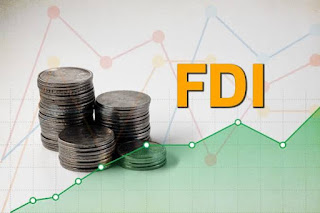Foreign Direct Investment
Foreign Direct Investment, or FDI for short, is the process by which a firm or a person from one nation invests in assets or commercial ventures in another nation obtaining a 'lasting interest' and control of an enterprise.
'Lasting interest' denotes the presence of a long-term partnership between a direct investor and the business, as well as a substantial level of control over the business's management.
Establishing commercial operations or purchasing material assets like buildings, equipment, or stock in businesses are typically involved in this.
FDI can take many different forms, including intra-company financing, new facility construction, reinvesting overseas enterprises' profits, and mergers and acquisitions.
Key points
- FDI involves a company or individual from one country investing in another country’s business or assets.
- FDI is a term used to describe a long-term interest in or influence over a foreign business, frequently involving control or a sizable amount of influence over management.
- FDI boosts a host country's economy by creating jobs, improving infrastructure, and transferring technology and skills.
- Many nations use incentives like tax cuts, special economic zones, or loosened rules to attract foreign direct investment (FDI).
- FDI promotes the integration of economies, facilitating global trade and cooperation.
There are two main types of FDI:
Greenfield investment:
Establishing new operations or facilities in a foreign country from scratch. For example, building its own facilities such as factories, offices, or distribution centers.
It often leads to substantial job creation in the host country because new facilities require a workforce.
Brownfield investment:
Acquiring or merging with an existing foreign business or facilities rather than building it from scratch.
Since the infrastructure is already in place, operations can start more quickly than with Greenfield investments.
Components of FDI
The components of FDI can generally be categorized into three broad types:
Equity Capital
This is the term used to describe the direct investment made by acquiring ownership shares in a foreign business, typically in the form of preferred or common stock.
Example: Buying shares in a local company abroad to gain a controlling interest.
An equity capital stake of 10 percent or more is normally considered a threshold for the control of assets.
Reinvested Earnings
Profits that the overseas subsidiary makes and keeps on hand rather than sending back to the parent nation. (Not distributed as divided) Retained earnings may be utilised for business expansion or project investments within the host nation.
Example: A multinational company grows locally by leveraging the income from its overseas division.
Other direct investment capital
This refers to loans or financial transactions between the parent company and its foreign affiliates. It can include both long-term and short-term lending between the headquarters and its subsidiaries abroad.
Example: A parent company provides funding to its subsidiary abroad for expansion or operational needs.
Together, these elements establish the structure of FDI and support the economic growth of the host nation as well as the investor. Every one of these elements has the potential to be quite important for how companies grow globally and incorporate into other markets.



Comments
Post a Comment